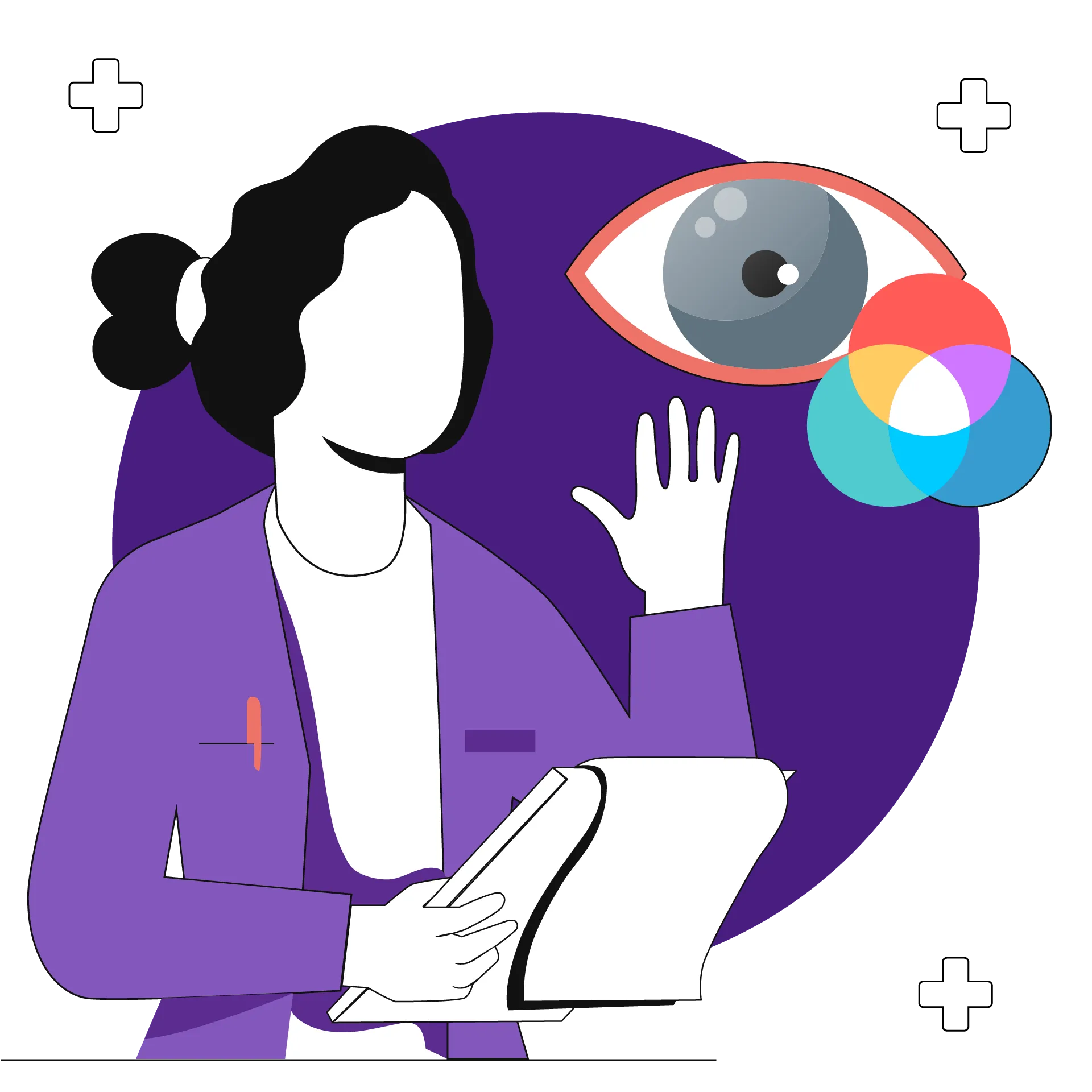Ent Surgeon | 8 min read
Color Blindness: Types, Causes, Treatments, Risk Factor
Medically reviewed by
Table of Content
Synopsis
Color blindness usually distinguishes shades of red, green, yellow, or blue. As a result of contradictions in the photoreceptors in the eye, except in the case of genetic origin, knowing the cause of your color blindness may help correct the condition.
Key Takeaways
- Color blindness is a condition that most people are born with
- Color blindness is a visual defect characterized by an inability to distinguish between colors
- Currently there are no treatments for hereditary types of color blindness, but some methods assist color blind patients
Color blindness, also known as color vision deficiency (CVD), is a condition where you do not see colors as most people do.
Color blindness is not the same as blindness (a condition in which you have limited or no sight) — color blindness is simply a change in how your eyes perceive color. We all see a spectrum of colors, but which ones we see depends on how well our photoreceptors work. Photoreceptors are cells in your eyes that respond to specific light wavelengths.
Most people can see some colors correctly but cannot distinguish others. Men are more likely than women to be color blind; approximately 1 in 12 men are color blind, compared to about 1 in 200 women. [1]
This can occur if specific cells in the retina of your eyes, known as photoreceptors or cones, are missing or not functioning correctly. Typically, these cones allow you to see every color of the rainbow. However, if you are color blind, for example, red-green color blind, you may not be able to see all of these colors.
There is also a link between color blindness and nearsightedness.
How Common is Color Blindness?
Everyone perceives color differently, and our perception of color may change as we age and if we develop age-related eye conditions such as thyroid eye disease and cataracts.
Although color blindness is uncommon, it does run in families. If other family members are color blind, you are more likely to be. Color blindness can occur in both men and women, but it is far more common in men. This is because color blindness is inherited through your genetic code.
Color blindness can also manifest later in life. For example, it may have been present at birth in some cases, but nobody noticed it until later.
In other cases, eye injuries or diseases can cause malfunctions in the parts of the visual system that allow color vision, such as the photoreceptors, nerves, and some retinal layers. World Glaucoma Week, celebrated every year in March, spreads awareness and helps people with color blindness to be healthier and adapt better.

Symptoms of Color Blindness
If you have difficulty seeing colors, you may have color blindness. Some symptoms of color blindness include:
- Differentiating between different colors
- Recognizing the brightness of specific colors
- Telling the difference between different shades
Color blindness symptoms and signs differ depending on the type. For example, if you inherited your color blindness (hereditary color blindness), the symptoms are often subtle because you've always seen colors the same way.
You may be unaware that there is another way to perceive colors. However, if you have acquired color blindness (color blindness caused by an injury or illness), you may notice a change in how you see colors. Some diseases that affect color vision progress too slowly for changes to be detected.
Types of Color Blindness
The functioning of the cones determines the type of color blindness. Given below are the different kinds of color blindness:
Monochromatism:
When people have monochromatism, they cannot distinguish between colors. This is usually due to the absence or total malfunction of the cones present on the retina. However, a person can identify the color of the objects based on their brightness. This blindness is extremely rare and usually occurs with other vision-related issues
Dichromatism:
Occurs when a person has two functional types of cones, and the third type of cone is missing or not functioning correctly. As a result, the missing cones cannot perceive a specific section of the light spectrum
Deuteranopia (Red Green Color Blind):
In deuteranopia or red-green color blindness, the green cone cells in the retina are absent or inactive. When a person has this problem, they see a mixture of green and red colors. In addition, they are unable to distinguish between those colors. This is the most common of all types of color blindness
Tritanopia (Blue Color blind):
A person with tritanopia lacks blue cone cells and cannot differentiate between yellow and blue colors. This type of blindness is exceptionally uncommon
Trichromatism:
A type of color blindness in which all three types of cells that perceive light and color function usually, but there is a shift in the sensitivity of the wavelengths in one of those colors
Additional Read: Night Blindness: Causes and Symptoms
Causes Color Blindness
The retina is responsible for color perception which houses the rods and cones. The cones distinguish between white, black, and grayscale, while rods are responsible for distinguishing red, blue, and green are given to the former. Their collaborative efforts allow for accurate color and shade recognition.
Daltonism:
This is a type of color blindness that occurs when the stamens, cones, or both are abnormal or absent, color blindness occurs. The causes are typically hereditary or a result of a disease
Genes:
The majority of cases of color blindness are inherited. Most of the time, the problem is passed down from mother to child and is unrelated to any visual defect. Even though women carry the faulty chromosome that causes their disease, men are more likely to inherit it
Anxieties:
Certain medications may cause changes in your color perception. Certain antipsychotic drugs, such as chlorpromazine and Thorazine, can cause color blindness. In addition, color perception can be altered by the antibiotic ethambutol used to treat tuberculosis. When prescribing medications, the physician should consider side effects
Additional Read: Seasonal Depression SymptomsDiseases:
Color blindness can be caused by certain eye conditions. Cataracts can damage the optic nerve, impairing your ability to perceive colors and shades. Macular degeneration and diabetic retinopathy both cause retinal degeneration. Color perception is not lost with cataracts, but it is significantly reduced. Some other diseases, such as diabetes, multiple sclerosis, Alzheimer's, and Parkinson's, can also cause color blindness
Others:
Color vision can deteriorate with age. Toxic chemicals in some plastic types, such as styrene, can cause color blindness.
Who is at Risk of Developing Color Blindness?
Color blindness affects most people from birth, having been passed down through the family. It can also happen due to an eye injury, illness, or certain medications. You may be more susceptible to color blindness if you are:
- Males
- Have family members who are color blind
- Use medications that alter your vision
- Suffer from eye diseases such as age-related macular degeneration, glaucoma, or cataracts
- Suffer from Alzheimer's, diabetes, or multiple sclerosis (MS)
Is Color Blindness Associated with Other Health Issues?
The most common type of color blindness, red-green color blindness, does not result in further vision loss or total blindness. However, because the cone cells of the retina are also used to see fine details, color-blind people may have less sharp vision. Other, more uncommon types of color blindness can accompany other vision problems that require the attention of an eye doctor, particularly in children. Therefore, anyone who suspects they are color blind should first schedule an eye exam. Therefore:
- If your child is color blind, speak with your eye doctor about assistive devices that can improve your vision
- If you notice any other vision problems that appear to worsen, contact an ENT Surgeon immediately
Color Blindness Treatment and Management
Color blindness is currently incurable. If a medication causes your color blindness, your doctor may advise you to try a different medication that does not cause the same side effects. If an injury or disease causes your color blindness, your doctor will usually treat the underlying causes. Treating the underlying cause of your color blindness may aid in the correction of the condition.
If your color blindness is inherited, there are gene therapies in development that could help you in the future. Meanwhile, get a doctor consultation on what assistive devices might help you work around your or your child's color blindness and adapt to it.
If you or your child is color blind, there are several things you can do. There are tools available to assist you in your daily activities, such as:
Lenses For Correction:
Tinted contact lenses and glasses are available to help you or your child reduce some of the bright light that can be an issue for color-blind people. They do not color-correct but help you see better by reducing brightness and glare. Check with your doctor to ask about color-blind glass's cost.
Color-Correcting Glasses:
Color-correcting glasses have recently come up, but they appear to only work for one type of color blindness. You can see your doctor and ask them for the color blind glasses cost
Color Buddy:
Many people with color blindness find it helpful to have a friend with full-color vision assist them with specific tasks, such as going to the store to buy paint or clothing.
Memory Aids:
Memory aids can be excellent workarounds for daily tasks. There is no reason why a person with a color vision deficiency cannot drive. Certain memory aids, such as remembering that green always appears at the top of traffic lights, can be helpful
Visual Aids:
Numerous devices, apps, and other visual aids are available to assist you in distinguishing between different colors. Some phone apps will take a photo of you and then interpret the colors in each section. A healthy lifestyle and Yoga for eyes are also known to help people with color blindness symptoms.
There is no cure for color blindness. However, diagnosis may enable a person or their parents/teachers to accommodate the condition actively. Special lenses may assist people with color blindness with specific color tasks, but they do not provide the wearer with 'normal color vision.' People can use mobile apps to help them identify colors. You can also get a doctor consultation from Bajaj Finserv Health within the comfort of your home.
References
- https://www.colourblindawareness.org/colour-blindness/
- https://www.nei.nih.gov/learn-about-eye-health/eye-conditions-and-diseases/color-blindness
Disclaimer
Please note that this article is solely meant for informational purposes and Bajaj Finserv Health Limited (“BFHL”) does not shoulder any responsibility of the views/advice/information expressed/given by the writer/reviewer/originator. This article should not be considered as a substitute for any medical advice, diagnosis or treatment. Always consult with your trusted physician/qualified healthcare professional to evaluate your medical condition. The above article has been reviewed by a qualified doctor and BFHL is not responsible for any damages for any information or services provided by any third party.





